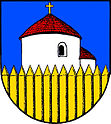Staré Město u Uherského Hradiště
| Staré Město | ||||
|---|---|---|---|---|
|
||||
| Basic data | ||||
| State : |
|
|||
| Region : | Zlínský kraj | |||
| District : | Uherské Hradiště | |||
| Area : | 2083 ha | |||
| Geographic location : | 49 ° 5 ' N , 17 ° 27' E | |||
| Height: | 205 m nm | |||
| Residents : | 6,652 (Jan 1, 2019) | |||
| Postal code : | 686 02-686 03 | |||
| License plate : | Z | |||
| traffic | ||||
| Street: | Otrokovice - Kyjov | |||
| Railway connection: | Otrokovice - Hodonín | |||
| structure | ||||
| Status: | city | |||
| Districts: | 1 | |||
| administration | ||||
| Mayor : | Josef Bazala (as of 2020) | |||
| Address: | náměstí Hrdinů 100 686 03 Staré Město |
|||
| Municipality number: | 550752 | |||
| Website : | www.staremesto.uh.cz | |||
Staré Město , until January 1, 1996 officially Staré Město u Uherského Hradiště (German old town in Hungarian Hradisch , formerly Veligrad ) is a city in the Czech Republic . It is located one kilometer northwest of Uherské Hradiště on the March and belongs to the Okres Uherské Hradiště .
geography
Staré Město is located in the March plain opposite Uherské Hradiště on the right bank of the March at the confluence of the Salaška. The Baťův kanál ends at the eastern edge of the city .
Neighboring towns are Jalubí in the north, Huštěnovice , Kněžpole and Jarošov in the northeast, Rybárny in the east, Uherské Hradiště in the southeast, Kostelany nad Moravou in the southwest, Zlechov and Tupesy in the west and Velehrad and Modrá in the northwest.
history
During the Moravian Empire, Veligrad was an important fortress and one of the centers of the empire. In the "annales fuldenses" the place was referred to as an unnamed fortress of Prince Rastislav in 869 . According to ancient traditions, Holy Method is said to have died and was buried on April 6, 885 in Veligrad.
Veligrad-Staré Město is first mentioned in a document from the Olomouc bishop Heinrich Zdik from 1141 . After the Velehrad Monastery was founded by Margrave Vladislav Heinrich in 1205, the village was transferred to the Cistercian monastery . The monastery built the monastery building hut in Veligrad-Staré Město. The place became the market of the monastery, and the St. Vitus Church and the parish were built.
With the 1257 by Ottokar II Premysl. Made establishing the royal city Nový Veligrad on a southeast, river island in March, the king transferred the marketing rights of Veligrad-Stare Mesto to the new city. In 1323 both places were given new names to distinguish them from Velehrad Monastery. From Veligrad-Stare Mesto was Antiqua civitas-Stare Mesto and the royal Nový Veligrad was Hradiště called. After the monastery was destroyed by the Hussites in 1423 , Staré Město was pledged to the city of Hradiště and in 1550 part of the Hradiště property.
In 1645 the Swedes Staré Město burned down during the Thirty Years War .
In 1789 the St. Vitus Church was torn down. In 1790 the place consisted of 166 houses and had 1124 inhabitants. In 1841 the Kaiser-Ferdinand-Nordbahn was inaugurated. Due to the rail link, companies settled here, such as the May Brothers sugar factory founded in 1868.
After the abolition of patrimonial Staré Město was a suburb of the Hungarian Hradisch from 1850 to 1943 , but had no town charter and was not a market town. In 1900 the population was 3879. In 1909 the new town hall was inaugurated. An attempt to obtain city rights in 1922 was in vain. In 1930, 6,211 people lived in the 1142 houses in the old town. In 1943 the first incorporation into Hungarian Hradisch took place. From 1945 to 1949 Staré Město became independent again and then again to the district of Uherské Hradiště. In the period between 1954 and 1971, the place broke away from the neighboring city. The hobby archaeologist Antonín Zelnitius discovered a settlement in the Moravian Empire in the 20th century and after his death it was expertly excavated under the direction of Vilém Hrubý. It has been accessible as a Great Moravia Memorial since 1960.
The next incorporation took place in 1971. On January 1, 1991 Staré Město u Uherského Hradiště became an independent municipality and on January 1, 1996 put the addition u Uherského Hradiště from the official name. Staré Město has been a town since November 1st, 1997.
Town twinning
- Sées , France
- Tönisvorst , Germany
Attractions
- Great Moravia monument
- Church of St. Michael, rebuilt in 1734
- Baťův kanál
- Statue of St. John of Nepomuk
sons and daughters of the town
- František Omelka (1904–1960), author
- Josef Panáček (* 1937), marksman
Individual evidence
- ↑ Český statistický úřad - The population of the Czech municipalities as of January 1, 2019 (PDF; 7.4 MiB)

